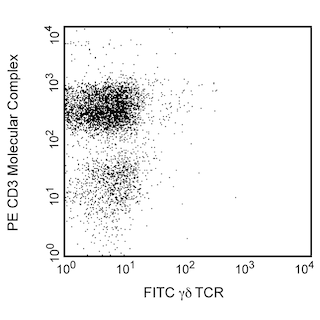-
Reagents
- Flow Cytometry Reagents
-
Western Blotting and Molecular Reagents
- Immunoassay Reagents
-
Single-Cell Multiomics Reagents
- BD® AbSeq Assay
- BD Rhapsody™ Accessory Kits
- BD® Single-Cell Multiplexing Kit
- BD Rhapsody™ Targeted mRNA Kits
- BD Rhapsody™ Whole Transcriptome Analysis (WTA) Amplification Kit
- BD Rhapsody™ TCR/BCR Profiling Assays for Human and Mouse
- BD® OMICS-Guard Sample Preservation Buffer
- BD Rhapsody™ ATAC-Seq Assays
-
Functional Assays
-
Microscopy and Imaging Reagents
-
Cell Preparation and Separation Reagents
-
Training
- Flow Cytometry Basic Training
-
Product-Based Training
- BD FACSDiscover™ S8 Cell Sorter Product Training
- Accuri C6 Plus Product-Based Training
- FACSAria Product Based Training
- FACSCanto Product-Based Training
- FACSLyric Product-Based Training
- FACSMelody Product-Based Training
- FACSymphony Product-Based Training
- HTS Product-Based Training
- LSRFortessa Product-Based Training
- Advanced Training
-
- BD® AbSeq Assay
- BD Rhapsody™ Accessory Kits
- BD® Single-Cell Multiplexing Kit
- BD Rhapsody™ Targeted mRNA Kits
- BD Rhapsody™ Whole Transcriptome Analysis (WTA) Amplification Kit
- BD Rhapsody™ TCR/BCR Profiling Assays for Human and Mouse
- BD® OMICS-Guard Sample Preservation Buffer
- BD Rhapsody™ ATAC-Seq Assays
-
- BD FACSDiscover™ S8 Cell Sorter Product Training
- Accuri C6 Plus Product-Based Training
- FACSAria Product Based Training
- FACSCanto Product-Based Training
- FACSLyric Product-Based Training
- FACSMelody Product-Based Training
- FACSymphony Product-Based Training
- HTS Product-Based Training
- LSRFortessa Product-Based Training
- United States (English)
-
Change country/language
Old Browser
This page has been recently translated and is available in French now.
Looks like you're visiting us from {countryName}.
Would you like to stay on the current country site or be switched to your country?


.png)

Two-color analysis of Vδ 6.3 TCR expression on intestinal intraepithelial lymphocytes (IEL). C57BL/6 IEL were simultaneously stained with FITC-conjugated mAb GL3 (antimouse γδ TCR, Cat. no. 553177, both panels) and PE-conjugated mAb 8F4H7B7 (Right panel). Flow cytometry was performed on a BD FACScan™ Flow Cytometry System (BD Biosciences, San Jose, CA).
.png)

BD Pharmingen™ PE Hamster Anti-Mouse Vδ 6.3/2 TCR
.png)
Regulatory Status Legend
Any use of products other than the permitted use without the express written authorization of Becton, Dickinson and Company is strictly prohibited.
Preparation And Storage
Product Notices
- Since applications vary, each investigator should titrate the reagent to obtain optimal results.
- Please refer to www.bdbiosciences.com/us/s/resources for technical protocols.
- Although hamster immunoglobulin isotypes have not been well defined, BD Biosciences Pharmingen has grouped Armenian and Syrian hamster IgG monoclonal antibodies according to their reactivity with a panel of mouse anti-hamster IgG mAbs. A table of the hamster IgG groups, Reactivity of Mouse Anti-Hamster Ig mAbs, may be viewed at http://www.bdbiosciences.com/documents/hamster_chart_11x17.pdf.
- Caution: Sodium azide yields highly toxic hydrazoic acid under acidic conditions. Dilute azide compounds in running water before discarding to avoid accumulation of potentially explosive deposits in plumbing.
Companion Products
.png?imwidth=320)

The 8F4H7B7 antibody reacts with Vδ 6.3/2 T-cell Receptor (TCR)-bearing T lymphocytes. Originally defined as a member of the Vδ 6 TCR subfamily, it is now proposed that the C57BL-derived Vδ 6.3 is an allelic variant of Vδ 6.2, found in A/J, AKR, BALB/c, C3H/He, and FVB mice. mAb 8F4H7B7 crossreacts with Vδ 6.4 and possibly Vδ 6.6 in DBA/2 mice, and it also detects a subset of γδ TCR-bearing cells in CBA/J and C57L mice. It does not recognize Vδ 4, Vδ 5, Vδ 6.1, or Vδ 6.5 TCR. A subpopulation of thymocytes expressing Vδ 6.3 or Vδ 6.4 TCR (in C57BL/6 or DBA/2 mice, respectively) and low levels of CD90.2 (Thy-1.2) shares functional and phenotypic characteristics with NK-T cells. Similar δV 6.4 TCRexpressing lymphocytes make up significant proportions of the γδ T-cell populations in the liver and spleen of DBA/2 mice. Furthermore, T lymphocytes bearing Vδ 6.3/2 TCR are found in the skin and intestinal epithelium and may represent a unique T-cell subpopulation with a potential for autoimmune reactivity.

Development References (5)
-
Azuara V, Grigoriadou K, Lembezat MP, Nagler-Anderson C, Pereira P. Strain-specific TCR repertoire selection of IL-4-producing Thy-1 dull gamma delta thymocytes. Eur J Immunol. 2001; 31(1):205-214. (Immunogen). View Reference
-
Azuara V, Lembezat MP, Pereira P. The homogeneity of the TCRdelta repertoire expressed by the Thy-1dull gammadelta T cell population is due to cellular selection. Eur J Immunol. 1998; 28(11):3456-3467. (Biology). View Reference
-
Gerber DJ, Azuara V, Levraud JP, Huang SY, Lembezat MP, Pereira P. IL-4-producing gamma delta T cells that express a very restricted TCR repertoire are preferentially localized in liver and spleen. J Immunol. 1999; 163(6):3076-3082. (Biology). View Reference
-
Kalataradi H, Eyster CL, Fry A. Allelic differences in TCR gamma-chains alter gamma delta T cell antigen reactivity. J Immunol. 1994; 153(4):1455-1465. (Biology). View Reference
-
Nagler-Anderson C, McNair LA, Cradock A. Self-reactive, T cell receptor-gamma delta+, lymphocytes from the intestinal epithelium of weanling mice. J Immunol. 1992; 149(7):2315-2322. (Biology). View Reference
Please refer to Support Documents for Quality Certificates
Global - Refer to manufacturer's instructions for use and related User Manuals and Technical data sheets before using this products as described
Comparisons, where applicable, are made against older BD Technology, manual methods or are general performance claims. Comparisons are not made against non-BD technologies, unless otherwise noted.
For Research Use Only. Not for use in diagnostic or therapeutic procedures.
Report a Site Issue
This form is intended to help us improve our website experience. For other support, please visit our Contact Us page.